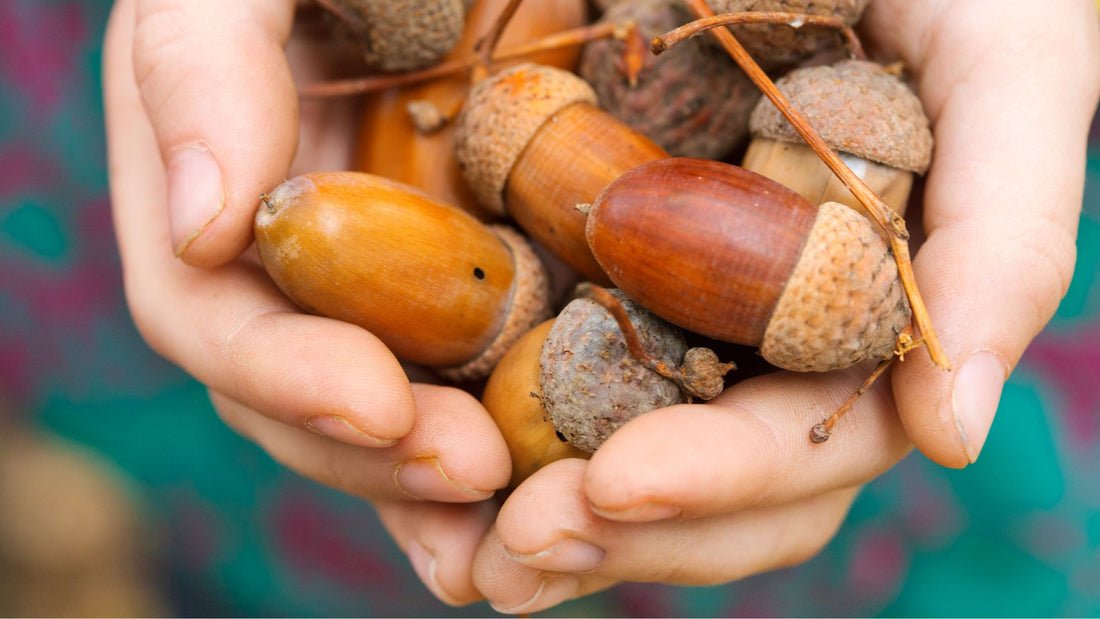
Photo: TWR trail cam catches a group of deer feeding on acorns at night.
But why is there such an abundance this year? The answer to that is simple: It’s a mast year.
Each year oak trees produce a yield of acorns. These acorns fall to the ground destined to become food for hungry wildlife. In a normal year, a lucky few will avoid this fate to germinate and grow into trees. However, in a mast year, acorn production is prolific. Such a massive yield of acorns ensures there will be plenty left over, even after wildlife has had their fill. More acorns left behind means that more will have a chance to grow into mighty oaks one day.

Photo: Turkeys peruse the trails at TWR in search of one of their favorite snacks.
How often does this happen? Can you predict this?
Masts happen irregularly every 2-5 years. While there are predictors that might provide us with an inkling that mast may happen, the exact timing is a mystery scientists have yet to crack. One theory is that unusually dry falls may trigger masting. Warm springs allow for better pollination odds for oak flowers, therefore potentially creating a larger yield of acorns. When it comes to coordinating these mast years, we look to the oaks to silently signal this phenomenon.

Science, Mystery, and The Wood Wide Web
Mast years do not occur for individual trees but instead occur across a region for the majority of trees of the same species. How do trees signal to one another that now is the time for a masting year? This is where we have fact and yet another mystery. Trees are able to communicate different needs, warning signals, and triggers for events like masting through a variety of networks. Trees send out these messages through the air, water, and most importantly through the soil.
Found underground is a network of fungi that connects the tree root system of one tree to another. This is known as a mycorrhizal network, often referred to as “The Wood Wide Web”. The symbiotic relationship between the fungi and tree allows both to thrive in ways scientists are still working to understand. With these tools trees are able to synchronize masting, but questions still remain. How far do these networks extend to allow for masting to occur across multiple forests in a region? Or do oaks have another secretive way to signal one another for masting? Research has shown partial synchrony in oak trees as far as 500 miles apart during mast years.

Photo: White oaks fill with acorns in early Fall at Three Waters Reserve.
Human Relationships with Mast Years
Small scurrying critters are not the only ones who have been historically impacted by acorn production patterns. Prior to European influences, indigenous human populations such as Southern Wisconsin’s Ho-Chunk, depended on acorns as an important food source as well. Developing processes like boiling, rinsing and grinding to remove the acorns’ bitter tannins and make them more palatable. To learn more about Southern Wisconsin’s indigenous populations including culture and food traditions, be sure to register for next week’s Lunch & Learn: Exploring Indigenous Heritage.

Photo: TWR Foraging Workshop attendees learn about processing acorns.
Why does masting occur?
Masting is an evolutionary trait developed by different types of trees such as oaks, white spruce, maples, beech, and hickory trees. It is believed this trait developed to help ensure the survival and reproduction of the species. Producing a surplus of acorns ensures not all will be eaten by wildlife, this leaves behind acorns that are given the chance to grow into oak trees. It is also believed that in between mast years oaks may limit their acorn production, not only in an effort to recoup nutrients and energy from producing the mast, but to starve the wildlife populations in the area. This limits predator populations from increasing, so that when a mast year occurs there are fewer animals feeding on the bountiful harvest.

